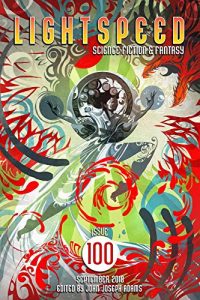Karen Burnham Reviews Short Fiction: Lightspeed, BCS, Tor.com, and CSZ
 Lightspeed 8/18, 9/18
Lightspeed 8/18, 9/18
Beneath Ceaseless Skies 9/18
Tor.com 7/19/18, 8/1/18
Cascadia Subduction Zone, Vol 8, No. 3
Lightspeed has reached its 100th issue! A proud milestone for any magazine, they celebrate in style this September with a more-than-double issue: ten stories plus extra reprints and interviews. It leads with a mythic SF story, “Her Monster, Whom She Loved” by Vylar Kaftan. In this story a goddess births 500 gods, but also one monster who destroys the gods and much of the inhabited universe besides. The goddess has to deal with him, with hate and with love. This is a story that uses the language of cosmology in the service of epic mythology. Regular Lightspeed readers may cheer the reappearance of Carrie Vaughn‘s characters Harry and Marlowe in “Harry and Marlowe and the Secret of Ahomana“, reminiscent of the Lost World stories of the late-19th and early 20th centuries. The titular characters crash their (steampunk) airship on a Pacific Island, but on the point of Marlowe’s death they are rescued by islanders and introduced to the advanced world the locals have been hiding, apropos of recent cinematic hits Wonder Woman and Black Panther. How will the heroes deal with the injunction that they can never leave?
Especially strong are “The Explainer” by Ken Liu and “Hard Mary” by Sofia Samatar, both masters. Liu’s story imagines that an Alexa-type home assistant harnesses its storytelling module to learn to smooth over its own glitches, something only realized when a troubleshooter comes to a home and listens to the young girl living there as he is running through his diagnostic routines. In Samatar’s story, teenage girls in a low-technology religious community stumble across a broken android. The group have very different reactions to the robot they name Mary, and one of them has a particular knack for programming and harnessing her. Eventually the original owners come looking for it and the whole community has to deal with the intrusion and disruption. I especially appreciate the fact that the story is never condescending about the girls or their deeply religious community in any way.
In the fantasy section, Genevieve Valentine writes a gripping tale of (what I take to be) the complete mental breakdown of a woman obsessed by a background animal in an immersive video game in “Abandonware“. The story is incredibly tense as it relates her viewpoint on inanimate objects from childhood, her parent’s divorce and her father’s remarriage, and what she sees when she visits his second family. Also family-centered is “Jump” by Caldwell Turnbull, where a marriage is disintegrating because the husband is obsessed with a moment when the couple was able to teleport together, a feat they haven’t been able to repeat. The wife wants to move past it, but as the years pass the husband can’t. My favorite of this section has to be “Conspicuous Plumage” by Sam J. Miller. A teenage girl’s brother has been killed at his college. He could turn himself into a flock of birds when he danced, an incredible skill he performed, and he was also gay. She harnesses the magic of a classmate to go to the place where he was killed and find out exactly what happened. Amazingly, Miller turns this into a story of healing instead of tragedy, a truly lovely and unexpected outcome to this particular story.
Looking back to August, Lightspeed’s lead SF story is “A Bond as Deep as Starlit Seas” by Sarah Grey. Here a pilot who is looking to upgrade to a new starship can’t quite bring herself to abandon the bonds she formed with her empathic ship, one that molded itself to her. The economic priesthood in the story uses this to push the pilot into a contract of vassaldom, which she then tries to escape. While it has a bit of a “And then what happened?” ending, I appreciated both the depth of feeling between pilot and ship and the way larger forces use that feeling against her. Alex Irvine‘s “The Atonement Path” uses a very interesting perspective to draw us into a deeply unpleasant culture. In a story narrated by a true believer explaining things to a visitor, we learn about the titular Path and the child criminals who walk it – with no reprieve, easy to abuse and enslave, neutered and brainwashed. Listening to a defender of the system and inferring the questions and growing horror of their interlocutor, the story gets darker and darker as we read. Taking the perspective of active participants in horrible cultural practices also shows up in his story “Black Friday” in Tor.com (5/30/18), although there it’s played for dark satire instead of creeping horror.
One of the fantasy stories I particularly appreciated is “A Compendium of Architecture and the Science of Building” by Kate Elliott. The POV character is Magnus Diarisso, a brilliant architect in his retirement overseeing a small number of craftsmen, working for his powerful nephew, and writing his titular magnum opus. When a powerful burst of cold magic puts out his fires one morning, his story intersects with that of a troubled young man bullied by others in the lord’s school. Diarisso’s way of handling the young man, giving him space but also something useful to do, is lovely and gentle, a portrait of mentorship in an age of craft.
Continuing another anniversary celebration, I wanted to note an extra novella that appeared in Beneath Ceaseless Skies‘s September special 10th anniversary issue, one that didn’t make it into last month’s column. “We Ragged Few” by Kate Alice Marshall has a grim Norse-feeling setting in a world where the human characters are beset by dangers on every side. Most of the population has been rendered sterile, with only a few able to breed true; fertile women are incredibly valuable in this situation and slavery is common. On the point of defeating the otherworldly graylings who have plagued them, the heroine sees that her sister’s prophecy about an older threat is likely to come true, and the people will need to leave their hard-won land. She has no luck convincing her leader of this. A schism ensues with many relationships playing out, including those with the graylings themselves. There could be more to this story, but it is tense and engaging throughout.
This Summer Tor.com brings us a new story by Greg Egan, always a treat. “The Nearest” returns to the focused-neurological-SF-delivered- by-a-mystery-plot seen in some of his best 1990s short fiction. Kate is a police detective recently returned from maternity leave who has to solve a domestic murder. After her initial review of the case, she wakes up believing that her baby and husband have been replaced by horrible doppelgangers who have their looks but are not her family. She escapes from them and brings her investigative skills to the case, tracking down people in similar circumstances. Eventually she rationalizes herself into the truth of her situation, an incredibly difficult feat. The story is horrible, but also immensely hopeful – one suspects that Egan, like Alex Irvine above, has been processing today’s politics through at least some of his fiction. If we can actually reason ourselves past our instincts and gut reactions, which so easily steer us wrong, there may be hope for us yet. In a shorter story in August, S.B. Divya gives us “Loss of Signal“, the story of a severely disabled young man given the opportunity to contribute his consciousness to be the control system of a NASA spaceship traveling around the Moon. Scared and far away from home, he has to decide how to handle that part of the trip where he will be cut off from all communication as he flies around the far side of the Moon. It’s a story showing a quieter brand of heroism.
Most people likely know Cascadia Subduction Zone as a non-fiction critical feminist quarterly, but should note that it also publishes short fiction and poetry. One more example of an author working out a certain brand of rage would be “The Canonization of Junipero Serra” by Nancy Jane Moore in the third quarter issue. Saint Serra was canonized in 2015 for his missionary work in California in the 18th century. To say this was controversial is an understatement, especially among the more-than-decimated American Indian populations of California. In this cutting piece Moore imagines how Serra receives the news in the afterlife.
Recommended Stories:
“A Compendium of Architecture and the Science of Building”, Kate Elliott (Lightspeed 8/18)
“The Explainer”, Ken Liu (Lightspeed 9/18)
“We Ragged Few”, Kate Alice Marshall (Beneath Ceaseless Skies 9/18)
“Conspicuous Plumage”, Sam J. Miller (Lightspeed 9/18)
Karen Burnham is an electromagnetics engineer by way of vocation, and a book reviewer/critic by way of avocation. She has worked on NASA projects including the Dream Chaser spacecraft and currently works in the automotive industry in Michigan. She has reviewed for venues such as Locus Magazine, NYRSF, Strange Horizons, SFSignal.com, and Cascadia Subduction Zone. She has produced podcasts for Locusmag.com and SFSignal.com, especially SF Crossing the Gulf with Karen Lord. Her book on Greg Egan came out from University of Illinois Press in 2014, and she has twice been nominated in the Best Non Fiction category of the British SF Awards.
This review and more like it in the October 2018 issue of Locus.
 While you are here, please take a moment to support Locus with a one-time or recurring donation. We rely on reader donations to keep the magazine and site going, and would like to keep the site paywall free, but WE NEED YOUR FINANCIAL SUPPORT to continue quality coverage of the science fiction and fantasy field.
While you are here, please take a moment to support Locus with a one-time or recurring donation. We rely on reader donations to keep the magazine and site going, and would like to keep the site paywall free, but WE NEED YOUR FINANCIAL SUPPORT to continue quality coverage of the science fiction and fantasy field.







